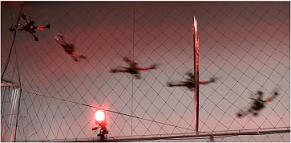
Holy crap, the quadrotors at UPenn’s GRASP lab are cool. Grad student Daniel Mellinger has had a busy summer with his autonomous flying drones, teaching them how to pick up objects, perch, and operate a spy camera. His latest video, just released, showcases a drone performing some impressive aerial stunts. The four bladed ‘copter recovers from being tossed around, flies in tight circles, and dodges through hoops. As if that wasn’t enough, the quadrotor can even zip through hoops as they are tossed in the air. That’s right, the drone matches the acceleration of the hoop and then dives horizontally through it while it falls. It’s freakin’ amazing! Check out the videos below to see the quadrotor in action.
The last time we saw UPenn’s quadrotor it was using bursts of speed to fly through any window at any orientation, all the while buzzing like a hive. Since then UPenn has unleashed some new and impressive videos for their four bladed dynamo. Not only can this bot perform some complicated aerial feats, it’s being upgraded for surveillance and autonomous flight as well. Watch the first video to get your fix of awesome aeronautics but stick around for the rest to see even more cool accomplishments.
So, what do you do with a flying drone that can perform complex aerial stunts? You put a claw on it. Earlier in the summer Mellinger (and I should also credit his advisor Prof. Vijay Kumar), had the drone landing on objects, picking them up and carrying them off. Pretty neat. But it gets better. He then taught groups of the drones to work in unison so they could carry off even larger objects. I couldn’t help but cackle maniacally during the grasping/carrying video below. Kidnapper drones that sound like hornets! Delightfully evil.
Following up on the grasping project, the UPenn drone was then taught how to perch on wooden platforms and operate a pivoting spy camera. You know…these things are sounding more and more like some weird robotic version of the flying monkeys from the Wizard of Oz.
The work shown in the above videos has a big limitation – it (largely) depends on the lab environment in which it is performed. There are many cameras set up around the flying space that capture images of the drones and other objects in real time. Along with inertial measurements from inside the drone, the lab system has a sort of omniscience for what’s happening in the space. This allows for the split second timing and course plotting we see in the first video. I should also point out that while all the innovative programming for the drones has been developed by UPenn, the drones themselves are purchased from Ascending Technologies.
I recently reviewed a quadrotor from PixHawk at ETH that could autonomously navigate itself using onboard sensors, not external cameras in its environment. As a commenter quickly pointed out, this makes the PixHawk quadrotor closer to real world applications even if it’s aerial stunts aren’t nearly as impressive as the UPenn work.
Well, things move fast in the quadrotor world. The same day I wrote my PixHawk article (the day before publication coincidentally), UPenn’s GRASP lab released a video of their quadrotor performing its own autonomous flight using onboard sensors. And this work was even better than PixHawk’s! The usual suspects at GRASP, along with grad student Shaojie Shen, got their quadrotor to travel in real work environments both indoors and outdoors. Not only that, but they did so without using any sort of markers, the drone simply mapped its surroundings with a laser scanner and camera. This is some impressive work, even if it’s not as flashy as watching the drone fly through hoops or carry off Dorothy.
[image credit: Daniel Mellinger]
[source: GRASP]


